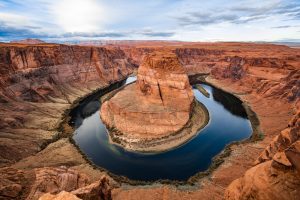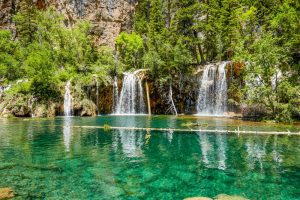It is undeniable that deserts are among the most fascinating splendors of mother nature. As most people commonly know, a desert is characterized by extremely low rainfall levels throughout the year, and it is expected to be a hot and sandy region.
However, there are also cold deserts which are also known as polar deserts.
All deserts combined cover about a third of the earth’s land surface. In this article, we explore the 10 largest deserts on earth and include information on location, size, and wildlife.
This article includes both cold and hot deserts.
The Antarctic Desert is the largest desert by size with an area of 14,200,000 km2 or 5,500,000 sq mi.
Following the Antarctic Desert, the second-largest desert is the Arctic Desert and the third-largest is the Sahara Desert.
Continue reading this article to learn about the complete list.
Table of Contents
1. The Antarctic Desert – 5.5 Million Square Miles

- Area: 14,200,000 km2 or 5,500,000 sq mi
- Location: South of the Antarctic Circle in Antarctica
- Type: Polar ice and tundra
The Antarctic Desert is located in the south of the Antarctic Circle in Antarctica, which is the fifth-largest continent in the world.
It is the largest desert on earth with an area of 14,200,000 km2 or 5,500,000 sq mi. The temperature can go as low as -89.2 °C or -128.6 °F but can also reach 10°C or 50 °F during the summer season.
The most common animals found in the desert are penguins, fur seals, and gulls. Despite being a desert, it is occupied by approximately 1,000 to 5,000 people depending on the season.
Those who come to the Antarctic Desert are usually tourists, researchers, and fishermen.
2. The Arctic Desert – 5.4 Million Square Miles

- Area: 13,900,000 km2 or 5,366,820 sq mi
- Location: Canada, Finland, Greenland, Iceland, Jan Mayen, Norway, Russia, Svalbard, Sweden, United States of America
- Type: Polar ice and tundra
The Arctic Desert is the second-largest desert by area, spanning approximately 13,900,000 km2 or 5,366,820 sq mi.
It is a polar region located in parts of Eastern Europe, Northern Europe, Northern Asia, and Northern America.
As you can expect from a polar cold desert, the climate in summer is cool but warmer in the Coastal Arctic, whereas winter is cold and snowy, dropping to -40 °C or -40 °F.
Several types of animals inhabit the Arctic Desert including snowy owls, caribous, Grizzly bears, polar bears, seals, belugas, and moose.
Aside from animals living in the desert, indigenous people also call the desert their homes such as the Inuit, Chukchi, and Evenks.
The indigenous population is all protected by the Arctic Council which comprises eight nations: Canada, the United States, the Kingdom of Denmark, Finland, Iceland, Norway, Sweden, and Russia.
3. The Sahara Desert – 3.5 Million Square Miles

- Area: 9,200,000 km2 or 3,552,140 sq mi
- Location: Algeria, Chad, Egypt, Eritrea, Libya, Mali, Mauritania, Morocco, Niger, Sudan, Tunisia, and Western Sahara
- Type: Subtropical
Known as the Greatest Desert, the Sahara Desert is an arid hot desert located in parts of Eastern Africa, Western Africa, Northern Africa, and Middle Africa.
It is the third-largest desert in the world and also the largest subtropical desert with a total area of 9,200,000 km2 or 3,552,140 sq mi.
Moreover, it is also considered the hottest place in the world with temperatures rising above 40 °C or 104.0 °F and even up to 80 °C or 176 °F for the sand temperatures.
The Sahara Desert contains six ecoregions or ecozones: Atlantic coastal desert, North Saharan steppe and woodlands, Sahara Desert, South Saharan steppe and woodlands, West Saharan montane xeric woodlands, and Tibesti-Jebel Uweinat montane xeric woodlands.
Trees, palms, and succulents are among the 500 plant species found in the desert. Some of the animals you will encounter are foxes, cheetahs, and camels.
4. The Arabian Desert – 1.0 Million Square Miles

- Area: 2,300,000 km2 or about 900,000 sq mi
- Location: Iraq, Jordan, Kuwait, Oman, Qatar, Saudi Arabia, the United Arab Emirates, and Yemen
- Type: Subtropical
The Arabian Desert is the second-largest subtropical desert in the world and the largest in the Arabian Peninsula.
It is an arid hot desert occupying Western Asia in an area of about 2,300,000 km2 or 900,000 sq mi, which is almost 1 million square miles already.
One of its most important natural resources is its below-ground water supply, as well as oil and natural gas.
If you are traveling around the Arabian Desert, you can easily do so with automobiles and railroads. You may get lucky enough to get a glimpse of oryx, red foxes, gazelles, and sand cats.
It is also worth mentioning that 4.23% of its land are protected areas and it also has several reserves including Harrat al-Harrah Reserve, Al-Tabayq Special Nature Reserve, and Uruq Bani Ma’arid Reserve.
5. Gobi Desert – 0.5 Million Square Miles

- Area: 1,295,000 km2 or 500,002 sq mi
- Location: China and Mongolia
- Type: Cold winter desert
Nestled in Eastern Asia lies the Gobi Desert, stretching an area of 1,295,000 km2 or 500,002 sq mi. It is the fifth-largest desert on earth that is found in China and Mongolia.
There are five ecoregions in the Gobi Desert: Alashan Plateau semi-desert, Dzungarian Basin semi-desert, Eastern Gobi Desert steppe, Gobi Lakes Valley desert steppe, and Tian Shan range.
Generally, the climate is usually cold and snowy at times with an average temperature of -21 °C or -6 °F.
However, temperatures in the Gobi Desert can be extreme, ranging between -47 to 34 °C or -53 to 93 °F.
The Gobi Desert played a key role in finding some of the most significant archeological discoveries including dinosaur eggs, fossil treasures, and prehistoric tools.
6. Patagonian Desert – 0.26 Million Square Miles

- Area: 673,000 km2 or 259,847 sq mi
- Location: Argentina, Chile, and Falkland Island
- Desert type: Cold winter desert
The Patagonian Desert is the sixth-largest desert in the world and the largest in Argentina covering an area of 673,000 km2 or 259,847 sq mi.
It consists of three regions: Eastern Patagonia, Western Patagonia, and Tierra del Fuego. Moreover, it is composed of four ecoregions which include Valdivian forests, Magellanic forests, Magellanic moorland, and Patagonian steppe.
About 12% of the ecoregions are protected areas that hold several national parks such as Laguna San Rafael, Los Glaciares, Nahuel Huapi, Torres del Paine, Alberto de Agostini, and Tierra del Fuego.
Wild animals such as burrowing owls, Patagonian gray foxes, western ribbon snakes, and pumas can be spotted in the desert.
People who live in the Patagonian Desert are usually farmers who raise livestock.
7. Great Victoria – 0.25 Million Square Miles

- Area: 647,000 km2 or 250,000 sq mi
- Location: Australia
- Type: Subtropical
The Great Victoria Desert was named after Queen Victoria in 1875. It stretches across Southern and Western Australia with an area of 647,000 km2 or 250,000 sq mi.
The desert is blanketed with grasslands and sand dunes and is inhabited by more than 100 reptile species.
Snakes, geckos, and goannas are some reptiles that are commonly found in the desert. Despite being a dry and subtropical region, some Australian Aboriginal people still live in the eastern part.
Moreover, the desert is used as a mining and nuclear weapons testing location.
8. The Kalahari Desert – 0.22 Million Square Miles

- Area: 518,000 km2 or 220,000 sq mi
- Location: Botswana, Namibia, and South Africa
- Type: Subtropical
Located in Southern Africa, the Kalahari Desert is a subtropical semi-arid desert that can be reached from Botswana, Namibia, and South Africa.
It consists of several protected areas including Central Kalahari Game Reserve, Kgalagadi Transfrontier Park, Khutse Game Reserve, and Tswalu Kalahari.
The tribes who live in the Kalahari Desert are the San people, Herero, Tswana, and Kgalagadi.
The Kalahari Desert is typically home to lions, leopards, hyenas, wild dogs, and cheetahs. However, the number of wildlife was significantly reduced due to grazing and raising cattle.
As a result, wild dogs like the African wild dog are now considered endangered in the desert.
9. The Great Basin Desert – 0.19 Million Square Miles

- Area: 492,098 km2 or about 190,000 sq mi
- Location: The United States
- Type: Cold winter desert
The Great Basin Desert is the ninth-largest in the world and is among the four major deserts in North America.
It is bordered by the Northern Basin and Range, Sierra Nevada, and Wasatch and Uinta Mountains.
The desert is home to more than 200 bird species and more than 100 mammal species.
In an effort to conserve, about 76% of the desert is protected. It is extremely cold in winter and extremely hot in summer.
The average temperatures can be more than 90 °F or 32 °C during the day and 40 °F or 4 °C at night.
10. Syrian Desert – 0.19 Million Square Miles

- Area: 469,954 km2 or 181,449 sq mi
- Location: Syria, Iraq, Jordan, and Saudi Arabia
- Type: Subtropical
The 10th largest desert is the Syrian Desert or the Syrian Steppe. It is located in Western Asia, specifically in some parts of Syria, Iraq, Jordan, and Saudi Arabia.
Moreover, it shares borders with the Orontes Valley and the Euphrates.
In fact, the desert covers about 85% of Jordan’s land. In this semi-arid hot desert, you can find several animals like storks, golden hamsters, raptors, snakes, and scorpions.
In the desert today, livestock is raised and sheep and goats are grazed, which also poses a threat to the ecosystem due to overgrazing.

















